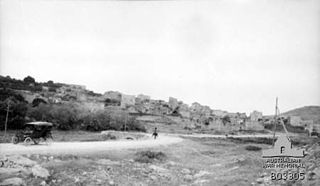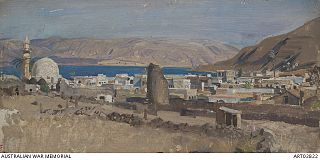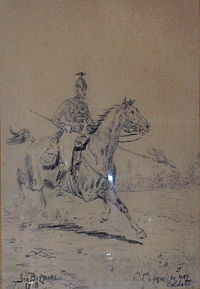
The charge at Krojanty, battle of Krojanty, the riding of Krojanty or skirmish of Krojanty was a Polish cavalry charge on the evening of 1 September 1939, the first day of the Second World War, near the Pomeranian village of Krojanty. It occurred at the start of the invasion of Poland and was part of the larger Battle of Tuchola Forest. Polish soldiers advanced east along the railway to a railroad crossroads 7 kilometres (4.3 mi) from the town of Chojnice, where elements of the Polish cavalry charged and dispersed a German infantry battalion. Machine gun fire from German armoured cars that appeared from a nearby forest forced the Poles to retreat. However, the attack delayed the German advance, allowing the Polish 1st Rifle Battalion and Czersk Operational Group to withdraw safely.

The Royal Scots Greys was a cavalry regiment of the Army of Scotland that became a regiment of the British Army in 1707 upon the Union of Scotland and England, continuing until 1971 when they amalgamated with the 3rd Carabiniers to form the Royal Scots Dragoon Guards.

The Independent Belgian Brigade was a Belgian and Luxembourgish military unit in the Free Belgian forces during World War II, commonly known as the Piron Brigade after its commanding officer Jean-Baptiste Piron. It saw action in Western Europe and participated in the Battle of Normandy, the Liberation of Belgium, and fighting in the Netherlands over 1944-1945.

The Battle of Liège was the opening engagement of the German invasion of Belgium and the first battle of the First World War. The city of Liège was protected by a ring of modern fortresses, one of several fortified cities to delay an invasion to allow troops from the powers which had guaranteed Belgian neutrality to assist the Belgian Army in the expulsion of the invaders.

The Battle of Mokra took place on 1 September 1939 near the village of Mokra, 5 km north of Kłobuck and 23 km north-west of Częstochowa, Poland. It was one of the first battles of the Invasion of Poland, during the Second World War, and was one of the few Polish victories of that campaign and the first German defeat of the conflict.

The Great Retreat, also known as the retreat from Mons, was the long withdrawal to the River Marne in August and September 1914 by the British Expeditionary Force (BEF) and the French Fifth Army. The Franco-British forces on the Western Front in the First World War had been defeated by the armies of the German Empire at the Battle of Charleroi and the Battle of Mons. A counter-offensive by the Fifth Army, with some assistance from the BEF, at the First Battle of Guise failed to end the German advance and the retreat continued over the Marne. From 5 to 12 September, the First Battle of the Marne ended the Allied retreat and forced the German armies to retire towards the Aisne River and to fight the First Battle of the Aisne (13–28 September). Reciprocal attempts to outflank the opposing armies to the north known as the Race to the Sea followed from (17 September to 17 October).

The First Battle of the Masurian Lakes was a German offensive in the Eastern Front 2–16 September 1914, during the Russian invasion of East Prussia. It took place only days after the Battle of Tannenberg where the German Eighth Army encircled and destroyed the Russian Second Army. Using the rapid movements aided by the East Prussian railway network, the Eighth Army reformed in front of the spread-out Russian First Army and pushed them back across their entire front, eventually ejecting it from Germany. Further progress was hampered by the arrival of the Russian Tenth Army on the Germans' right flank.

The Battle of Halen, also known as the Battle of the Silver Helmets because of the many cavalry helmets left behind on the battlefield by the German cuirassiers, took place on 12 August 1914 at the beginning of the First World War, between German forces led by Georg von der Marwitz and Belgian troops led by Léon De Witte. The name of the battle alludes to the Battle of the Golden Spurs in 1302, where 500 pairs of golden spurs were recovered from the battlefield. Halen was a small market town and a convenient river crossing of the Gete and was situated on the principal axis of advance of the Imperial German army. The battle was a Belgian tactical victory, but did little to delay the German invasion of Belgium.
The Battle of Koziatyn of 25–27 April 1920 was one of the most spectacular raids of the Polish cavalry during the Polish–Soviet War. In the effect of a pincer maneuver some 160 kilometres behind the front line, the Polish Army was able to seize the strategically important town of Korosten. The town, a major railway hub and a Red Army supply depot, was captured with negligible Polish losses.

Lieutenant-general BEM Victor Jean Clement, Baron van Strydonck de Burkel was a general of the Belgian Army and the primary architect of the formation of the Free Belgian Forces after Belgium's official surrender on May 28, 1940 in World War II.
The Battle of Hannut was a Second World War battle fought during the Battle of Belgium which took place between 12 and 14 May 1940 at Hannut in Belgium. It was the largest tank battle in the campaign. It was also the largest clash of tanks in armoured warfare history at the time.

The Divisional Cavalry Regiment was an armoured cavalry regiment of the 2nd New Zealand Division during the Second World War and was New Zealand's first armoured unit. It served as a reconnaissance force for the 2nd New Zealand Division. Formed on 29 September 1939, the regiment embarked for Egypt on 4 January 1940. It fought with the division, as part of the 2nd New Zealand Expeditionary Force, in Greece, Crete, North Africa and Italy. The regiment formed part of J Force, New Zealand's contribution to the occupation of Japan at the end of the war.

The 15th Cavalry Brigade was a brigade-sized formation that served alongside British Empire forces in the Sinai and Palestine campaign, during World War I. Originally called the Imperial Service Cavalry Brigade it was formed from Imperial Service Troops provided by the Indian princely states of Jodhpur, Hyderabad, Mysore, and Patiala which each provided a regiment of lancers. A maximum of three regiments served in the brigade at any one time. The states of Kashmir, Idar and Kathiawar provided smaller detachments for the brigade, which was at times reinforced by other British Empire regiments and artillery batteries when on operations.

The Battle of Tabsor was fought on 19–20 September 1918 beginning the Battle of Sharon, which along with the Battle of Nablus formed the set piece Battle of Megiddo fought between 19 and 25 September in the last months of the Sinai and Palestine Campaign of the First World War. During the infantry phase of the Battle of Sharon the British Empire 60th Division, XXI Corps attacked and captured the section of the front line nearest the Mediterranean coast under cover of an intense artillery barrage including a creeping barrage and naval gunfire. This Egyptian Expeditionary Force (EEF) victory over the entrenched Ottoman Eighth Army, composed of German and Ottoman soldiers, began the Final Offensive, ultimately resulting in the destruction of the equivalent of one Ottoman army, the retreat of what remained of two others, and the capture of many thousands of prisoners and many miles of territory from the Judean Hills to the border of modern-day Turkey. After the end of the battle of Megiddo, the Desert Mounted Corps pursued the retreating soldiers to Damascus, six days later. By the time the Armistice of Mudros was signed between the Allies and the Ottoman Empire five weeks later, Aleppo had been captured.

The Battle of Nazareth began on 20 September 1918, during the Battle of Sharon, which together with the Battle of Nablus formed the set piece Battle of Megiddo fought during the last months of the Sinai and Palestine Campaign of the First World War. During the cavalry phase of the Battle of Sharon the Desert Mounted Corps rode to the Esdraelon Plain 40 and 50 miles behind the front line in the Judean Hills. At Nazareth on the plain, the 13th Cavalry Brigade of the 5th Cavalry Division attempted to capture the town and the headquarters of the Yildirim Army Group which was eventually captured the following day after the garrison had withdrawn.
The Capture of Afula and Beisan occurred on 20 September 1918, during the Battle of Sharon which together with the Nablus, formed the set piece Battle of Megiddo fought during the last months of the Sinai and Palestine Campaign of the First World War. During the cavalry phase of the Battle of Sharon, the 4th Cavalry Division of the Desert Mounted Corps attacked and captured the main communications hub at Afula, located in the centre of the Esdraelon Plain, and Beisan on the plain's eastern edge near the Jordan River, some 40–50 miles (64–80 km) behind the front line in the Judean Hills.

The Capture of Jenin occurred on 20 September 1918, during the Battle of Sharon which together with the Battle of Nablus formed the set piece Battle of Megiddo fought between 19 and 25 September during the last months of the Sinai and Palestine Campaign of World War I. During the cavalry phase of the Battle of Sharon carried out by the Desert Mounted Corps, the 3rd Light Horse Brigade, Australian Mounted Division attacked and captured the town of Jenin located on the southern edge of the Esdraelon Plain 40–50 miles (64–80 km) behind the front line in the Judean Hills. The Australian light horse captured about 2,000 prisoners, the main supply base and the ordnance depot of the Seventh and the Eighth Armies in and near the town. They also cut the main road from Nablus and a further 6,000 Ottoman Empire and German Empire prisoners, were subsequently captured as they attempted to retreat away from the Judean Hills.

The Capture of Tiberias took place on 25 September 1918 during the Battle of Sharon which together with the Battle of Nablus formed the set piece Battle of Megiddo fought between 19 and 25 September in the last months of the Sinai and Palestine Campaign of the First World War. During the cavalry phase of the Battle of Sharon the Desert Mounted Corps occupied the Esdraelon Plain 40–50 miles (64–80 km) behind the front line in the Judean Hills. One squadron from each of the 3rd and 4th Light Horse Brigades Australian Mounted Division attacked and captured Tiberias, along with the Yildirim Army Group's Ottoman and German garrison.

The Charge at Haritan occurred on 26 October 1918 at the end of the Pursuit to Haritan during the final stages of the Sinai and Palestine Campaign of the First World War. Two regiments of the 15th Cavalry Brigade, 5th Cavalry Division, charged into the retreating remnant column of the Ottoman Army's Yildirim Army Group. Subsequently, six squadrons of the same brigade charged into an Ottoman rearguard position but were counterattacked and forced to retreat.

The siege of Namur was a battle between Belgian and German forces around the fortified city of Namur during the First World War. Namur was defended by a ring of modern fortresses, known as the Fortified Position of Namur and guarded by the 4th Division of the Belgian Army. The purpose of the fortified Belgian cities was to delay an invasion force until troops from the states guaranteeing Belgian independence came to their aid. The French Fifth Army planned to counter-attack while the Germans were besieging Namur.

















